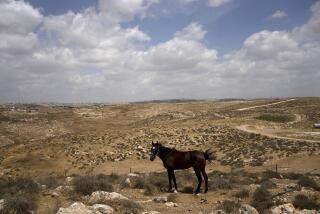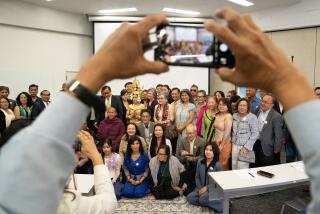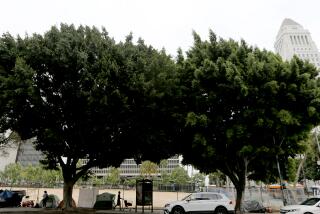Cambodian Relocation Stirs Controversy : Refugees Consolidated Into Two Civilian Camps Along Thailand Border
ARANYAPRATHET, Thailand — In the last six months, the Thai government has engineered a controversial relocation of Cambodian refugees along its eastern frontier, changing the strategic options in the seven-year-old border war.
A year ago, 10 camps occupied by guerrillas of the Cambodian resistance, their civilian supporters and families were situated just across the Cambodian border north and south of this district town.
Vietnamese troops attacked them all last winter and spring, driving a quarter-million panicky refugees into hastily cleared evacuation sites in Thailand.
Since the attacks ended, the Thais have closed the initial and secondary evacuation sites and have gathered the refugees in just two camps: Site Eight, about 40 miles south of Aranyaprathet, and Site Two, approximately the same distance to the north.
Khmer Rouge Camp
Site Eight holds 30,000 followers of the Khmer Rouge, the Communist faction of the three-part Cambodian resistance. It lies two miles from the border.
Site Two shelters 132,000 refugees, according to a just-completed census. They are supporters of the Khmer People’s National Liberation Front, the largest of the non-Communist resistance groups. The non-Communist followers of former Cambodian leader Norodom Sihanouk are encamped farther north on the border.
About 4,000 Vietnamese, including a small group of Montagnard tribesmen, are also held at Site Two, which is only 1 1/2 miles from the frontier.
Thai authorities have prevented armed guerrillas from entering the camps, a change from the situation a year ago when the camps were on the Cambodian side of the frontier, and even from six months ago, when weapons could be seen in some evacuation sites.
Site Two, which within six months has become what is believed to be the world’s second-largest “city” of Cambodians--after Phnom Penh--also satisfies a Thai priority of keeping refugees close to the border to discourage a “hemorrhage” of fleeing refugees.
Civilian Camps
The consolidation of camps presents the Vietnamese with a different sort of target, civilian camps. An attack on Site Two would be a clear violation of Thai territory and of the right of sanctuary.
From the Thai point of view, the reduction in the number of camps to two should make defense of the central sector less complex if not easier. But the camp’s location, chosen by the Thais, has been sharply criticized by relief workers here. It is well within range of Vietnamese artillery.
“We have never liked Site Two, and we have constantly told the Thai authorities so,” said David Morton, a top Bangkok official of the United Nations Border Relief Operation, the agency that supports the border camps.
Morton and other UNBRO officers would prefer the Site Two refugees be withdrawn to Site Three, a newly prepared, unoccupied site nearly six miles from the border.
The controversy grew in September, when more than 50,000 refugees were moved to Site Two from a camp adjoining the Khao-i-Dang holding center, far deeper in Thailand.
Safety Concerns
“The proximity of Site Two to the border gives us concern for the safety of the Khmers (Cambodians) there and for our own people as well,” Morton said.
Another relief official, recalling the panic of last winter, pointed out that Site Two is more than twice as populous as any camp evacuated then. And, he said, “There is just one road (leading from Site Two to Site Three) and, if there is an attack, the Thai military will be using that.
“The refugees would have to walk out, and it would take at least three hours,” he said. “And remember, 30% of the people in Site Two are under (age) 5, and they would probably have to be carried out.”
Except for its dangerous location, the camp is an improvement on its predecessors. The Cambodians have three times the room they had in their previous camp. The roads are high and wide, and there is ample passageway between huts.
Logistically, relief workers have no more problems supplying Site Two than they did the camps it replaced.
More to Read
Sign up for Essential California
The most important California stories and recommendations in your inbox every morning.
You may occasionally receive promotional content from the Los Angeles Times.










